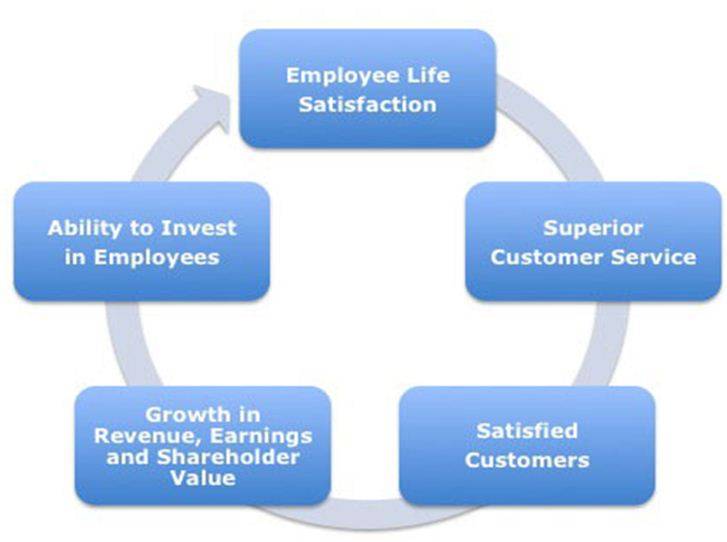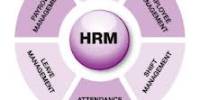Employee satisfaction
Employee satisfaction is a measure of how happy workers are with their job and working environment. Keeping morale high among workers can be of tremendous benefit to any company, as happy workers will be more likely to produce more, take fewer days off, and stay loyal to the company. There are many factors in improving or maintaining high employee satisfaction, which wise employers would do well to implement. Employee satisfaction is the terminology used to describe whether employees are happy and contented and fulfilling their desires and needs at work. Many measures purport that employee satisfaction is a factor in employee motivation, employee goal achievement, and positive employee morale in the workplace. Satisfied employees can satisfy customers & can get the organizations goal easily.

Employee satisfaction, while generally a positive in your organization, can also be a downer if mediocre employees stay because they are satisfied with your work environment.
Factors contributing to employee satisfaction include treating employees with respect, providing regular employee recognition, empowering employees, offering above industry-average benefits and compensation, providing employee perks and company activities, and positive management within a success framework of goals, measurements, and expectations.
Employee satisfaction is often measured by anonymous employee satisfaction surveys administered periodically that gauge employee satisfaction in areas such as:
- management,
- understanding of mission and vision,
- empowerment,
- teamwork,
- communication, and
- Coworker interaction.
The facets of employee satisfaction measured vary from company to company.
A second method used to measure employee satisfaction is meeting with small groups of employees and asking the same questions verbally. Depending on the culture of the company, either method can contribute knowledge about employee satisfaction to managers and employees.
Measure employee satisfaction:
To measure employee satisfaction, many companies will have mandatory surveys or face-to-face meetings with employees to gain information. Both of these tactics have pros and cons, and should be chosen carefully. Surveys are often anonymous, allowing workers more freedom to be honest without fear of repercussion. Interviews with company management can feel intimidating, but if done correctly can let the worker know that their voice has been heard and their concerns addressed by those in charge. Surveys and meetings can truly get to the center of the data surrounding employee satisfaction, and can be great tools to identify specific problems leading to lowered morale.
Measuring employee satisfaction and productivity levels require the use of employee surveys and measurements of the performance indicators. Companies may use questionnaires and surveys to measure employee satisfaction. Some examples of the performance indicators are
Timeliness, quality, quantity and yearly performance appraisals. Regardless of how these things are measured, employee satisfaction and productivity can be the main ingredients for a successful organization.
Instruction:
- Design an employee satisfaction survey using a range of degrees of satisfaction. For example, the answers may be very satisfied at the highest range and not satisfied at all at the lowest range. Some questions can be about the work itself, supervisor, hours, environment, pay, benefits, co-workers, etc. Prepare at least 25 questions to gather a significant amount of data.
- Develop the tools to measure productivity levels by analyzing the job descriptions and required output. If it is a job that requires so many widgets to be produced in one hour, counting the number of widgets on an hourly basis is easy. If the job requires no more than three errors in a day’s productivity, it is simple to check for errors at the end of the day. Timeliness is measure by number of widgets produced per hour.
- Schedule meetings with supervisors and managers to review employee satisfaction and performance. Have a discussion about previous performance appraisals that revealed attitude.
Factors of Employee satisfaction:
Six factors that influence job satisfaction. When these six factors were high, job satisfaction was high. When the six factors were low, job satisfaction was low. These factors are similar to what we have found in other organizations.
Opportunity
Employee survey studies show that employees are more satisfied when they have challenging opportunities at work. This includes chances to participate in interesting projects, jobs with a satisfying degree of challenge, and opportunities for increased responsibility. Important: this is not simply “promotional opportunity.” As organizations have become flatter, promotions can be rare. People have found challenge through projects, team leadership, special assignments – as well as promotions.
Actions:
- Promote from within when possible.
- Reward promising employees with roles on interesting projects.
- Divide jobs into levels of increasing leadership and responsibility.
It may be possible to create job titles that demonstrate increasing levels of expertise which are not limited by availability of positions. They simply demonstrate achievement.
Stress
When negative stress is continuously high, job satisfaction is low. Jobs are more stressful if they interfere with employees’ personal lives or are a continuing source of worry or concern.
Actions:
- Promote a balance of work and personal lives. Make sure that senior managers model this behavior.
- Distribute work evenly (fairly) within work teams.
- Review work procedures to remove unnecessary “red tape” or bureaucracy.
- Manage the number of interruptions employees have to endure while trying to do their jobs.
- Some organizations utilize exercise or “fun” breaks at work.
Leadership
Data from employee satisfaction surveys has shown employees are more satisfied when their managers are good leaders. This includes motivating employees to do a good job, striving for excellence, or just taking action.
Actions:
- Make sure your managers are well trained. Leadership combines attitudes and behavior. It can be learned.
- People respond to managers that they can trust and who inspire them to achieve meaningful goals.
Work Standards
Employee survey data points out those employees are more satisfied when their entire workgroup takes pride in the quality of its work.
Actions:
- Encourage communication between employees and customers. Quality gains importance when employees see its impact on customers.
- Develop meaningful measures of quality. Celebrate achievements in quality.
Trap: Be cautious of slick, “packaged” campaigns that are perceived as superficial and patronizing.
Fair Rewards
Employees are more satisfied when they feel they are rewarded fairly for the work they do. Consider employee responsibilities, the effort they have put forth, the work they have done well, and the demands of their jobs.
Actions:
- Make sure rewards are for genuine contributions to the organization.
- Be consistent in your reward policies.
- If your wages are competitive, make sure employees know this.
- Rewards can include a variety of benefits and perks other than money.
As an added benefit, employees who are rewarded fairly, experience less stress.
Adequate Authority
Employees are more satisfied when they have adequate freedom and authority to do their jobs.
Actions:
When reasonable:
- Let employees make decisions.
- Allow employees to have input on decisions that will affect them.
- Establish work goals, but let employees determine how they will achieve those goals. Later reviews may identify innovative “best practices.”
- Ask, “If there were just one or two decisions that you could make, which ones would make the biggest difference in your job?”
Other factors influences / effects to employee satisfaction: It can include factors as following:
1. Organization development factors
• Brand of organization in business field and comparison with leading competitor.
• Missions and Vision of organization.
• Potential development of organization.
2. Policies of compensation and benefits factors
• Wage and salary
• Benefits
• Rewards and penalties
3. Promotions and career development factors
• Opportunities for promotion.
• Training program participated or will do.
• Capacity of career development
4. Work task factors
• Quantity of task
• Difficult level of task
5. Relationship with supervisor factors
• Level of coaching
• Level of assignment for employee
• Treatment to employee etc
6. Working conditions and environment factors
• Tools and equipment
• working methods
• Working environment
7. Corporate culture factors
• Relationship with coworkers
• Level of sharing etc
8. Competencies, Personalities and Expectations of employee factors
• Competencies and personalities of employee are suitable for job?
• Expectations of employee are suitable for policies of organization?
Many experts believe that one of the best ways to maintain employee satisfaction is to make workers feel like part of a family or team. Holding office events, such as parties or group outings, can help build close bonds among workers. Many companies also participate in team-building retreats that are designed to strengthen the working relationship of the employees in a non-work related setting. Camping trips, paintball wars and guided backpacking trips are versions of this type of team-building strategy, with which many employers have found success.
Of course, few workers will not experience a boost in morale after receiving more money. Raises and bonuses can seriously affect employee satisfaction, and should be given when possible. Yet money cannot solve all morale issues, and if a company with widespread problems for workers cannot improve their overall environment, a bonus may be quickly forgotten as the daily stress of an unpleasant job continues to mount.
If possible, provide amenities to your workers to improve morale. Make certain they have a comfortable, clean break room with basic necessities such as running water. Keep facilities such as bathrooms clean and stocked with supplies. While an air of professionalism is necessary for most businesses, allowing workers to keep family photos or small trinkets on their desk can make them feel more comfortable and nested at their workstation. Basic considerations like these can improve employee satisfaction, as workers will feel well cared for by their employers.
The backbone of employee satisfaction is respect for workers and the job they perform. In every interaction with management, employees should be treated with courtesy and interest. An easy avenue for employees to discuss problems with upper management should be maintained and carefully monitored. Even if management cannot meet all the demands of employees, showing workers that they are being heard and putting honest dedication into compromising will often help to improve morale
Model of Employee Satisfaction

Employee Satisfaction Questionnaire
Questionnaire
| Company & Contact Information | ||||||||||||||||||||||||||||||||||||||||||||||||||||||
| ||||||||||||||||||||||||||||||||||||||||||||||||||||||
Please select your department:
Foreign Exchange
IT Engineers
General Banking
Marketing
Investment
General Administration
Other
How long have you worked for (Company)?
Less than 3 months
3 months – 1 year
1 – 3+ years
4 – 6+ years
7 – 10+ years
10+ years
Do you satisfied about your salary?
Yes 80 %
NO 20%
Do you satisfied your working environment?
Yes 70%
No 30%
Are you satisfied about working hour?
Yes 45%
No 55%
How many hours do you prefer in a day?
8hours 80%
10hours 20%
What is your employee turnover rate per year
15%
Do you get on the job or of the job training?
Yes 100%
Do you feel working stress?
Yes 35%
No 65%
Our compensation is standard to market:
When you Compare to the other market competitors, are your salary package is the best?
Yes 60%
No 40%
Did you ever feel that your salary package will be changed?
Yes 100%
No 0%
Do you satisfied about your job
Yes 80%
No 20%
“Compensation” makes you to stay in this organization?
| Strongly Disagree 0% | |
| Disagree 10% | |
| Somewhat Agree 15% | |
| Agree 20% | |
| Strongly Agree 55% | |
| Not Applicable 00 |
Recommendation
Basically, an organization always efforts to increase the employees productivity to face the uncertain environment and always gets its change quickly. The environment change that occurs in any kids of position level, either in basic position, middle, and also top position. The development and innovation in technology and education that quickly happen, has been changing the job characteristics in which needs the special skill, make the employees should increase their skill and ability in completing their work well in order that they can give their high productivity to company. And the same things happened to Exim bank.
The employee productivity is the important discourse for Exim Bank, because it is related to the achievement and performance that can be achieved by employee. In which, it will influence the company performance too. Therefore, company should be able to increase the employee productivity. This can be completed by creating and maintain the work situation and condition that can encourage employee to increase their performance, either when do their job individually or together in a teamwork.
Employee productivity depends on the amount of time an individual is physically present at a job and also the degree to which he or she is “mentally present” or efficiently functioning while present at a job. Exim Bank need to address both of these issues in order to maintain high worker productivity, and this may occur through a variety of strategies that focus on employee satisfaction, health, and morale If an employee believes that their job is interesting and fun, they are more likely to work hard and attend work consistently.
On the other hand, if the employee of Exim bank believes that their job is boring or demanding a negative attitude will develop, leading to a decrease in productivity. Generally, the more productive people are, the more satisfied they tend to be productive employees. When employees feel satisfied they will be less likely to leave their work.Job satisfaction itself depends on the level of intrinsic and extrinsic outcomes and how the jobholder views those outcomes. These outcomes have different values for different people. For some people, responsible and challenging work may have neutral or even negative value depending on their education and prior experience with work providing intrinsic outcomes. For other people, such work outcomes may have high positive values. People differ in the importance they attach to the job outcomes. Those differences would account for different levels of job satisfaction for essentially the same job tasks.
Conclusion
From the aforesaid topic & my point of origin to work in Exim Bank Limited, I can say that I really enjoyed my internship period at Exim Bank Limited form the very first day. I am confident that this 3 (three) months internship program at Exim Bank of Bangladesh will definitely help me to realize my further career in the job market. I also understand:
“People don’t leave their jobs, they leave their managers.”
Although committed and loyal employees are the most influential factor to becoming an employer of choice, it’s no surprise that companies and organizations face significant challenges in developing energized and engaged workforces. However, there is plenty of research to show that increased employee commitment and trust in leadership can positively impact the company’s bottom line. In fact, the true potential of an organization can only be realized when the productivity level of all individuals and teams are fully aligned, committed and energized to successfully accomplish the goals of the organization.
As a result, the goal of every company should be to improve the desire of employees to stay in the relationship they have with the company. When companies understand and manage employee loyalty -rather than retention specifically – they can reap benefits on both sides of the balance sheet i.e., revenues and costs.
Today, employee loyalty needs to be earned, rather than assumed, and must be specific, rather than general – employees are looking at their employment as a means of achieving personal goals rather than simply being the “good corporate soldier” of the past. This means that companies need to express and act on a commitment to develop employees’ career objectives by introducing initiatives that make employees believe that their current job is the best path to achieving their career goals.
















